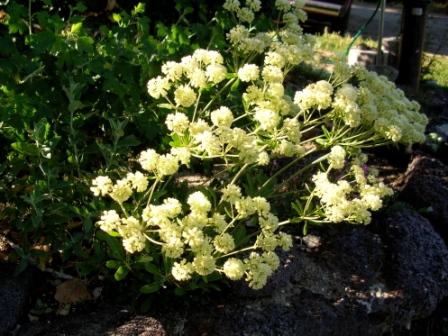Whorled Buckwheat in the Landscape

Diane Jones, Draggin' Wing Farm, Water-thrifty Plants for Idaho
Scientfic Name: Eriogonum heracleoidesCommon Name: Whorled Buckwheat, Wyeth Buckwheat, Parley Desert Buckwheat, Parsnipflower Buckwheat
Description: Slim leathery leaves on a low, woody mat give rise to numerous whorls of brilliant white, cream or yellow bon-bons in early summer.
Native Habitat: Foothills to subalpine, open rocky slopes, from about 4,000 up to 8,000' throughout the western Intermountain region.
Cultural Requirement
Soil: Well-drained, poor or even rocky soils to ordinary garden soil.
Moisture Tolerance: Very xeric.
Sun/Shade/Preference: Full sun.
Transplanting: Transplants well from containers.
Propagation: Seed.
Maintenance (pruning, fertilization, deadheading, division, irrigation, etc): No maintenance necessary. May remove dead flower stalks if desired.
Insect, disease, or other problems: None of concern.
Landscape Value
Use in the Landscape: Attractive evergreen groundcover for tough, dry spots. Use in low borders or xeric rock gardens.
Foliage: Narrow, dark green, leathery leaves with wooly undersides, persisting throughout the year.
Flower: Whorls of cream-colored pom-pom shaped flower heads often fading orange-red with age.
Timing: Mid-summer.
Color: White, cream to pale yellow.
Form: Short woody base with evergreen leaves; short to medium flower stalks above.
Texture: Leathery.
Ultimate Size: 20" x 20"
Rate of Growth: Moderate to slow.
Suggested Plant Partners: Sagebrush, Rabbitbrush, Woolly Sunflower.
Availability: Available at specialty nurseries.
Cultivars: None.
References:

